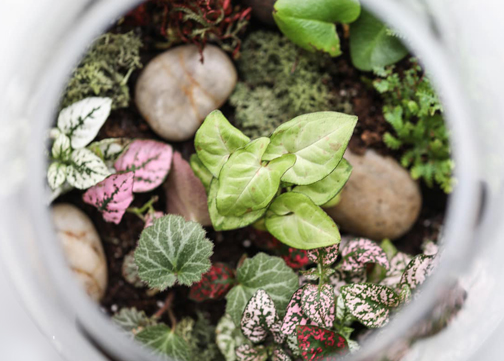
HOW TO MAKE A TERRARIUM

A Terrarium is a collection of compatible plants grown in an enclosed, clear container. Creating a terrarium is a practical and fun way to have a miniature landscape inside your home. Their easy care is ideal for people who are too busy to spend a lot of time caring for plants.
Materials Needed:
Clear container Plants Pebbles, pea gravel, or very coarse sand
Charcoal Sphagum moss Potting soil Accent pieces (optional)
Setting Up Your Terrarium:
- Start with a clean container. There are containers specifically designed for terrariums or you can use jars, fishbowls, aquariums, etc. ‘DishGardens’, containers without lids, are just as much fun to make in a variety of shapes and sizes.
- Create a 4 layer foundation:
- The bottom layer is for drainage, and consists of pea gravel, pebbles or very coarse sand. Proper drainage is essential to ensure that the soil doesn’t become over-saturated, which may lead to root rot and the death of your plants. Depending on the size of your container, you will want to spread at least an inch of drainage material evenly across the entire bottom of your terrarium. For large or deep containers, up to 3 inches of material may be used.
- Spread a thin layer of charcoal. This layer will help to clean the air of the fumes caused when the organic materials begin to decompose into the soil.
- The third layer is a thin cover of Sphagum Moss spread evenly over the charcoal. The purpose of this step is to prevent the soil from sifting down into the drainage layer, which would render it useless.
- The final step is a layer of quality potting soil. Try to avoid soils with fertilizers or soil moist crystals already added. If your intent is to create an open desert type container, make sure to use soil especially developed for cacti and other succulents. These soils contain sand for additional drainage.
Plant Selection:
- Make sure to select plants that are compatible in lighting, watering and humidity needs.
- Choose plants of varying height, shape, texture and color to create your desired effect.
- Small plants that do not grow too quickly are your best choice.
- Cacti and other succulent plants will not do well in a closed container.
Play!:
- Before you plant, take your time and make certain that the arrangement creates the desired WOW effect. While they are still in their pots, set the plants in the terrarium. Take a step back and make sure you like what you see. Once you have created the right ‘scene’, you are ready to plant.
Planting:
- Remove the plants from their pots, and set them in pre dug holes.
- Unlike planting in the garden, it is not necessary to loosen the plant’s roots. In a terrarium, you don’t want the plants to grow to quickly. Leaving the root ball compacted will slow down the growth of the plant.
- Firm the soil gently around the roots. Do not crowd the plants or place them directly against the sides of the container, allowing sufficient space for the plants to grow and spread.
- After planting, the soil should be slightly moistened.
- Place the lid on your terrarium.
Terrarium Maintenance:
- Never place a terrarium in direct sunlight. Terrariums trap in heat, and direct sunlight causes temperatures in terrariums to become too hot for most plants.
- Check the terrarium frequently for condensation on the glass. If large water droplets appear on the glass, the container should be left open for a while, until any excess moisture evaporates. It may be necessary to keep the lid slightly opened, to allow fresh air to circulate.
- Water the terrarium with a mister. Pouring water into a terrarium can dislodge the loose soil.
- When in doubt, always water less. Over watering quickly increases the danger of fungus or mold.
- ‘Dish gardens’ have water requirements similar to a regular houseplant. Because drainage is limited, make sure not to over water.
- Remove dead leaves and diseased plants immediately.
- Occasionally, you may need to prune or replace an overgrown plant.
HAVE FUN !!

